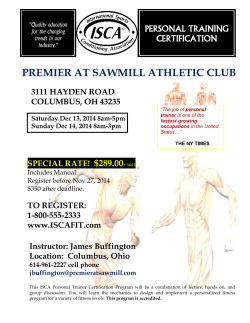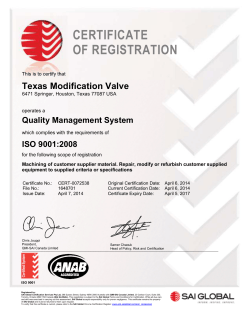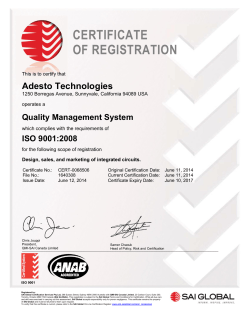
Certification: A Rewarding Endeavor
© Copyright AAMI 2015. Single user license only. Copying, networking, and distribution prohibited. Features Certification: A Rewarding Endeavor Stephanie Stephens Early in his career, Paul Kelley, like many Consider that lawyers must pass the bar and other biomedical equipment technicians, doctors must be licensed and pass their board struggled to understand the benefits of examinations within their states, Kelley says. professional certification. “They’ve demonstrated a minimum level of “People who were certified weren’t always education needed to do their job.” the cream of the crop,” Kelley, who started in Three years ago, the U.S. Department of 1979 and now is director of biomedical Veterans Affairs initiated a national certificaengineering and green initiatives at Washing- tion push for all its biomedical engineers, ton Hospital Healthcare System in Fremont, says Michelle Baquie, MBA, CCE. Baquie is a CA, says. “Often, there seemed to be no good biomedical engineer and healthcare technolreason for it. I thought it would cost me and ogy manager for the VHA Healthcare there’d be no return.” Technology Management Program Office. Thankfully, many Her organization funds healthcare facilities now clinical engineering Many healthcare facilities are rewarding healthcare preparation, supports now are rewarding technology management self-study and study healthcare technology (HTM) professionals who groups, and provides take the extra steps to helpful articles about management (HTM) become certified. Studying testing subjects, she says. professionals who for certification helps these “We have even offered take the extra steps to professionals develop face-to-face meetings, become certified. needed job skills and along with online opportuadvance their careers. nities and teleconferences, After leading a certificato help our employees tion study group for his local association in prepare for certification. During our initial 2003, Kelley figured he’d done the work and study course, we found that clinical engimight as well take the test. He passed, and neers with 25 or more years in the field he’s glad he did. walked away learning things that helped “Now I help my staff with their test study them be better engineers.” needs and we pay for the tests they pass,” he The agency is also currently hosting a pilot says. “Having 100 percent certification on phase CBET study course, both in-person staff shows they care about our field. It’s like and online, “because technicians also benefit getting a degree, and is definitely more from certification,” she says. important than it used to be.” Approximately 40 percent of engineers, About the Author Stephanie Stephens, MA, is a freelance writer, producer, and multimedia expert. E-mail: stephanie@ stephaniestephens.com Biomedical Instrumentation & Technology January/February 2015 23 © Copyright AAMI 2015. Single user license only. Copying, networking, and distribution prohibited. Features The AAMI Credentials Institute For its part, AAMI is placing a new and unparalleled emphasis on certification and accreditation that will help propel HTM professionals’ competency and career to the next level. “AAMI wants to help professionals grow and advance, and certification is just one of our offerings to help fulfill that mission,” says Iman Hannon, CM, AAMI’s certification manager. AAMI’s Board of Directors recently created the AAMI Credentials Institute (ACI), replacing the USCC and ICC, says Jan paul Miller, in-house director of credentials. Members of the US BMET Board of Examiners, USCC, and ICC now will serve on the ACI’s board and its committees, he says. “The ACI will handle all certification activities without any loss of validity or credence,” Miller says. “Credentials staff are currently informing applicants, candidates, and certificants of the change. As usual, candidates must meet minimum eligibility requirements, pay the required fees, and engage in ongoing professional development activities once they’re certified.” Additionally, the new institute will seek ANSI accreditation for all certifications and will be applying to the Accrediting Body for Engineering Technology (ABET) to be the lead member society, he says. As an ABET member, the ACI will review post-secondary curricula in biomedical technology. ACI’s last function will be to accredit assessment-based certificates (ABC) for AAMI University and other third-party professional development providers. Perhaps most exciting, says Miller, is that AAMI will deploy two new certifications March 2, 2015: a certification for quality system managers (CQSM) and one for healthcare technology managers (CHTM). Eligibility requirements and details for both were set to be released in January. This year also will herald the rollout of an industrial sterilization certification and another information technology certification, probably in early in the fourth quarter. CERTIFICATION 24 technicians, and site managers are certified at University of Pittsburgh Medical Center (UPMC) in Pittsburgh, says Keith Radakovich, senior director of clinical engineering. Like Kelley’s employer, UPMC has provided pre-test learning materials and testing fees, but also a small salary increase to those who successfully pass the test. Still, change is inevitable so it’s wise to plan, Radakovich says. “If certification is a current benchmark, we should also anticipate what’s ‘coming down the line’ next in our industry that may involve certification,” he says. Recognizing Employers If employers want certified employees, they must provide incentives, says David Braeutigam, director of healthcare technology management at Baylor Scott & White Health in Texas. He formerly served on the U.S. BMET Board of Examiners and was most recently on the U.S. Certification Commission (USCC). “We should do more to recognize employers who reward certification because it demonstrates competency in one’s chosen career,” he says. Braeutigam applauds BMET requirements for either an associate’s degree or graduation from a military program. He also thinks showing actual work experience is a big differentiator between BMET and IT certification. “It’s about more than just meeting minimum requirements, paying your money, and taking a test,” he says. Like Kelley, Braeutigam remembers that during the 1980s “certification wasn’t such an important driver.” Then a colleague became certified and Braeutigam jumped in because of “personal pride,” he says. Now as a director, he believes if an employer requires staff certification, that management should follow suit. To that end, 21 out of 44 management and technical staff are certified at Baylor, and senior staff must have active certification. Because the staff sometimes balks at test cost, Baylor now pays for the CBET exam up front and also pays the recertification fee every three years, he says. “Certification puts a ‘seal of approval’ on our professional processes,” adds Christopher Nowak, regional vice president of operations at Crothall Healthcare. “As U.S. Biomedical Instrumentation & Technology January/February 2015 © Copyright AAMI 2015. Single user license only. Copying, networking, and distribution prohibited. Features BMET Board Chairman, I get questions from HTM professionals who ask, ‘Why do I need to know this clinical material? I’m not a nurse or doctor, so why are you asking questions about clinical stuff?’” He answers that passing an exam helps validate that technologists employed at his facilities are well-rounded professionals. “The clinical test questions add to their ability to talk the talk and walk the walk with clinicians and caregivers,” Nowak says. “HTM professionals must understand what physicians and nurses are discussing so they can obtain proper diagnostic data from the devices we all service daily.” Nowak’s employer also foots the bill for certification exams and for participation in daytime certification exam study sessions. “The return is well worth it to help develop employees who have a broader perspective about clinical outcomes for the patients we serve,” he says. Working Hand in Hand You probably already know that AAMI oversees CBET, CRES, and CLES certifications, while the American College of Clinical Engineering or ACCE oversees certification for clinical engineers—a process formerly handled by the Healthcare Technology Foundation (HTF). “Both professions work hand-in-hand to support and manage healthcare technology for their various organizations,” says immediate past ACCE president Jim Keller. He is also vice president of Health Technology Evaluation and Safety for the ECRI Institute in Philadelphia, PA. “We all deal with increasingly complex scenarios that affect how technology is deployed and managed,” says Keller, who thinks certification should be de rigueur for the clinical engineering profession as a whole. “It provides more legitimacy when dealing with inherent complexities, and assures administrators who hire our professionals that they’re getting quality individuals.” With 22 years as a clinical engineer— including 14 with the VA—Paul R. Sherman, CCE, FACCE, now does technical program management for his own Sherman Engineering in St. Louis, MO. As past HTF certification chair, Sherman also understands Many healthcare facilities now are rewarding healthcare technology management (HTM) professionals who take the extra steps to become certified. the meaning of quality, and explains that while AAMI certifications primarily are for technicians, CCE certifications stand alone because they’re for degreed engineers. “We know that AAMI and CCE are not competitive, but that they “I always compare certification complement each other,” he says. to a professional engineer’s “I always compare certification to license that documents a level a professional engineer’s license of expertise in one’s field.” that documents a level of expertise in one’s field.” — Paul R. Sherman Like his colleagues we’ve met here, Sherman hopes more engineers will get certified as more healthcare organizations encourage their employees to obtain it. “Employers who incentivize certification and continued professional development create a winning scenario for all concerned: the employer, certificant, patients, and the general public,” Jan paul Miller says. He is the first in-house director of credentials, hired to champion expanded certification. “Now with formation of the ACI, ‘the sleepy child’ over in the corner has finally reached maturity, as exemplified by this vibrant certification/ accreditation enterprise within AAMI.” n Biomedical Instrumentation & Technology January/February 2015 25
© Copyright 2025










